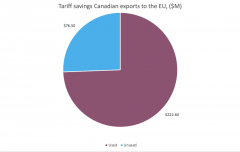The trade between Canada and the EU has seen exponential growth, seven years since CETA was implemented. Despite economic challenges due to the COVID-19 pandemic, trade relations between Canada and the EU still continue to be strong. The trade between Canada and the EU still grew a record high of $100 billion in 2021, a 33.7% increase compared to the 18.6% growth in 2016 that was recorded by overall Canadian merchandise trade over the same period (Global Affairs Canada).
Exports of Canada to the EU reached $32.5 billion in 2021, a 46.4% increase compare to 2016. Because of CETA, the duties that was saved in 2021 is estimated to $890.6 million, which also contributes to the increased competitiveness of Canadian business and consumers (Global Affairs Canada).
Canada-EU Trade Performance
Canada’s third largest merchandise trading partner is the EU. In 2021 alone, the EU accounted for 4.8% of Canada’s merchandise exports, and 11.0% merchandise imports.
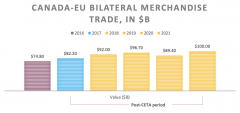
The merchandise export of Canada to the EU recorded an exceptional growth CETA came into force. The expansion from 2016 to 2021 reached a record high from $22.2 billion to $32.5 billion, an increase of 46.4%. Additionally, the Canadian merchandise imports from the EU has also seen a significant increase at 28.4%, which is $67.5 billion in 2021.
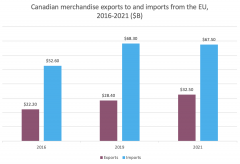
The Rising Number of Canadian Firms Trading with the EU
The implementation of CETA has also seen an increased number of Canadian businesses that engaged in trade with the EU since 2016. From 2016 to 2019, Canadian firms that exported goods to the EU rose from 7,753 to 8,291. The main driver of this growth are the small and medium-sized enterprises (SMEs), expanding from 7,295f SME exporters in 2016 to 7,787 in 2019. As of 2018, 11.7% of firms exporting to the EU are majority-owned by women, making the EU one of the most important destinations for women-owned firms (Global Affairs Canada).
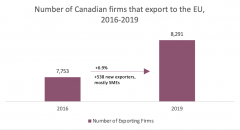
Trade by Partner
The Expansion of Canadian merchandise exports to the EU was due to increased exports to the following five EU member states: Germany, Belgium, the Netherlands, France, and Spain. These members have accounted for 85% of the total increase in Canadian exports to the EU. Moreover, exports to Latvia, Czech Republic, Greece, Poland, Bulgaria, and Lithuania grew by 230%, which is an estimated amount of $1.5 billion (Eurostat).
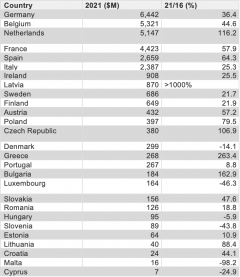
Trade by Province and Territory
From 2016 to 2021, eleven of the thirteen Canadian provinces and territories experienced an increased in exports to the EU. Newfoundland and Labrador led all the regions as its exports to the EU grew more than tripled compared to the pre-CETA years (Statistics Canada).
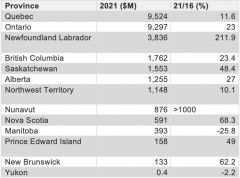
Trade Growth by CETA Preferences
Though the overall trade growth provides a very limited understanding the effects of CETA, Canadian exports to the EU in 2021 would have been $8.2 billion (or €5.5 billion) if CETA is not in effect. The sectors that experienced thee largest growth in Canadian exports of dutiable products to the EU by value from 2016 to 2021 are recorded below.
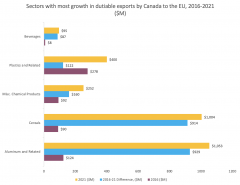
Total growth of dutiable imports in these sectors made up 36.8% of the total positive growth in imports of dutiable products.
Utilization of CETA Preferences for Canadian Exports to the EU
The CETA preference utilization rate (PUR) measures the extent of a products that are eligible for CETA preferential tariff rates. Since CETA was enforced, most tariff lines are duty-free. The customs utilization data collected provide an estimate of which importers and exporters are making use of the tariff reductions under CETA.
The sectors with the largest CETA-eligible amounts for Canadian products for exports to the EU are detailed below. The exports from these sectors made up 86.4% of all CETA-eligible exports that are originating to Canada.

Utilization of CETA Preferences for Canadian Imports from the EU
The utilization rate of CETA preferences in Canada for imports from the EU in 2021 is 59.5%, having a small increase of 4.1% points compared to the 55.4% in 2020. However, it saw a substantial increased from 38.4% in 2018 (Statistics Canada).

The utilization rates of CETA preferences for Canadian imports also vary greatly depending on the EU member states of origin. The differences from each EU member states are shown below (Statistics Canada).

Tariff Savings for Canadian Exports to the EU
With the implementation of CETA in 2016, the benefits of tariff savings can also pass to Canadian consumers who may see lower prices for EU imports. Tariff reductions enjoyed by Canadian products exported to the EU contributes to the lower prices and in turn, the improve competitiveness of Canadian firms within the EU market. In 2021, Canadian companies saved $221.6 million in duties. However, since CETA preferences are not yet fully utilized, there are still $76.5 million savings that are yet to be realized (Global Affairs Canada).
